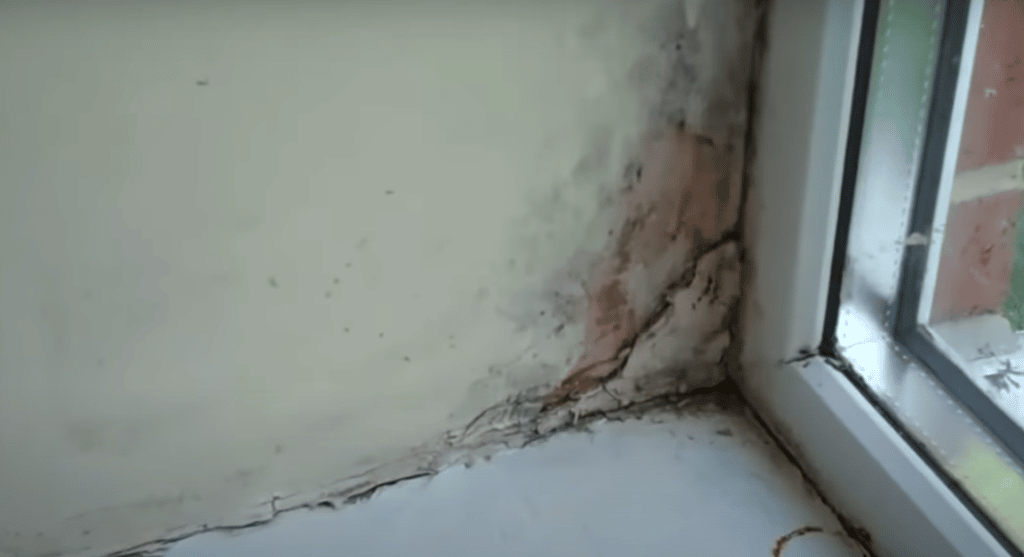Mouldy walls but the house isn’t damp
The above video highlights the case, that more often than not, mouldy walls are not the result of rising damp or penetrating rainwater.
As explained in the video this block of eight flats was constructed within the last ten years. It has a plastic damp course and a cavity wall. There is absolutely no evidence of a damp problem. Yet in the bedroom there are terribly mouldy walls; black in places.
A pre-purchase survey for the lender has raised the prospect of dampness and we, as Property Care Association members and being well known by the lender, were asked in to investigate. The client was the homebuyer so booked a survey with us. Externally the apartment is in excellent condition. The damp course is at least 150mm above the paths and is clearly visible. The flat is not occupied at the moment and the estate agent tells the surveyor it has been empty for a few weeks. The DPC in the inner leaf cannot be seen. However a thorough check all around the internal walls with an electronic moisture meter, reveals that the base of all of the plastered walls are dry.
So Why the Mouldy Walls?
Mould hates dry conditions, yet here are the stains from extensive and well established mould. There are two possibilities to be thought about:
- The mould is historic and was caused by a problem which is no longer there
- The mould is caused by a problem associated with the house being occupied, which it now isn’t.
Let’s look into what I mean by a historic problem. Penetrating rainwater if bad enough, can cause a damp patch which will get mouldy. A very bad roof leak, dripping overflow pipe or cracked down pipe can cause a similar problem. Has something like this happened? No, these defects leave other tell-tale signs of damage. They can cause mouldy walls, but alongside that you can expect surface disruption of the decorations, damage to the plaster and such. In the case of the external walls, the repair will often be visible, with green algae, moss or salt stained bricks too. There are none of these things. We can rule them out – the problem is not historic..
Occupation and mouldy walls
Could the mould be simply due to the environmental conditions in the house, when it was occupied? Is this the reason that the mouldy walls are dry? We can see no evidence of damp or any external repairs, which might suggest the house has ever been damp.
Let’s look at the location of the mould:
- It’s confined to bedroom corners, with a vertical triangle formed
- It is also in corners formed by the window reveals
- It is particularly bad behind a wardrobe, including the laminate floor
- It is also growing on the wardrobe itself, which is not touching the walls.
Read on for the full details or, why not speak to an expert now on Leeds 265 2752 York 566577 or Sheffield 224 5121 or email us via our contact page
This all points to mould induced by high relative humidity. Let’s work through the points made above:
The mould is in the corners – why? Well, corners are always a little cooler than elsewhere in a room. It’s to do with convected heat ‘cutting’ corners and, external corners losing heat a little faster (due to surface area). This applies to the window reveals too. Despite the fact that a cavity closer has probably been fitted, this is still a cold bridge of sorts, so they will be ever so slightly colder. Temperature is significant because of course when you lower temperature Relative Humidity rises – even if you do not add any more water vapour. Triangles of mould in corners are a strong indicator of an environmental problem. A problem with indoor air quality.
The mould is very bad on the wall which used to be behind the wardrobe. This too hints at an environmental problem. Leaks, rising damp and gutter problems don’t follow wardrobes around. However sometimes, especialy in a very humid property – mould does. This too is related to heat (or lack of), rather than dampness. Convected heat from the house heating system, is impeaded by the wardrobe. The wall behind it and the floor under it gets less heat – its wearing a wardrobe as a coat. Relative humidity behind the wardrobe and under it will be higher than elsewhere in the room.
The mould is growing on the laminated wardrobe and it’s hardboard back. This is a clincher for an environmental issue. For mould to grow on free standing items such as furniture, curtains, beds, items in drawers and such, the ambient relative humidity must be very high. Remember that the air actually touching the cold corners near the floor, or that bit of the window reveal behind the curtains is a bit sticky. Air does have a little friction and when it is up against a colder surface it will cool down. This zone of static air is known as the boundary layer.
Whilst the RH in any room may be low, sometimes a very cold surface will bring the temperature of air in contact with it (in it’s boundary layer), right down. If it falls enough (or if it was already quite saturated), the RH may reach 100%. We’ve all seen this when we get a bottle of beer out of the fridge. In this case the air in the boundary layer, in contact with the wardrobe has been cool enough, to bring on condensation or very near that level (over 85% at least – probably 100% now and again).
Despite what we read as children, our wardrobe is full of dresses and jeans; no Lion or Snow queen. The wardrobe cannot be colder than the outside walls (other than on a bright sunny day after a cold night, but that’s not for this video lecture). What we mean is that the wardrobe is not some sort of cold bridge. Thus, the evidence of mould on static independent items, which will be at or near the temperature of the surrounding air tells us; we have very high ambient relative humidity.
Mouldy walls due to ‘lifestyle’ or ‘building defects’?
We know for certain that this is an environmental issue. The RH must be high. What can cause this? It could be that the one bedroom flat had several people living in it. They all were girls, who washed their hair twice a day? Anything is possible. Maybe the heating was never turned on and this means that the air was cold and easily saturated, even though the owner lived alone? Could be.
The house is empty now and we can’t ask the owner or even measure the environmental conditions. These tests would tell us nothing. The house has no source of water vapour now, other than the rise and fall of the vapour pressures, tracking the external weather.
Our surveyor checks the layout, design and the mechanical ventilation for clues and finds:
- The bathroom has no windows
- The kitchen is communal with the lounge, with the cooker and sink on a party wall
- There is mechanical ventilation for the bathroom and the dining kitchen.
This is where the fun starts. This is a ground floor apartment with the roof of the complex about 6M above. The cooker hood is 6M from the external wall yet it has no ducting kit, so it is useless. The extraction for the kitchen is an intermittent extract fan in the upper corner, with a pull cord, which Bryan had to stretch to reach. It didn’t work anyway. The bathroom fan has no timer over-run (regulations specify 15 minutes if a wet room lacks opening windows).
Where home ventilation is concerned we seem to have a short memory.
In the video Bryan explains the background for the situation this owner finds themselves in. The design of the flat is poor and it is predisposed to mould problems. In the past, back-to back, houses were considered slums. Yet here we have a similar design, which is actually far less well ventilated than one of those old houses. Those were condemned as unfit to live in. At least they had a chimney and an open fire to ventilate the place. This one is sealed up, with double glazing and there is no chimney. The heating is provided by electric radiators, which suppy great heat quickly and are expensive to use. This means that the flat is cold in winter, until the owner gets home from work and turns them on. They heat up well, but the short time they are on, does not heat the fabric of the walls and floors well. As a result the flat cools quickly, when they are turned off. This causes huge peaks and troughs of heat, with corresponding and inverse peaks and troughs of RH% and condensation.
No kitchen or bathroom window either. The Building Regulations: Approved document Part F (means of ventilation), dictate that all wet rooms, like kitchens and bathrooms, should have sufficient extraction and that it should be designed, installed and commissioned. This is what is obviously wrong here. Is this why we have mouldy walls? Probably. The facts are that neither the surveyor or anyone else knows how the previous occupant lived. They may have preferred to leave the fans unused and boil cabbage on the hob all day long – we’ll never know.
What is clear, is that the mechanical ventilation and the heating in the property are very below par. From a surveyors perspective all we have to go on are the visual symptoms and the poor state of the mechanical ventilation. If a car breaks down and a tyre is flat, replace the wheel first, before you check oil pressure and the timing belt….
Our Recommendations:
Our advice in this case – fix the obviously defective and ill designed mechanical ventilation. Perhaps also give the buyer some advice on improved heating. Make sure that any new mechanical ventilation is not just bought and installed. It must be commissioned properly in accordance with best practice. Best practice is approved document part F of the buildings reg’s and The domestic ventilation compliance guide. This should be done by a ‘competent person’. As it happens that’s us, as we are Bpec qualified domestic ventilation engineers. We design, install and commission mechanical ventilations systems so they work – guaranteed.
Call us for friendly and knowledgeable advice or book a mould and condensation survey on Leeds 265 2752 York 566577 or Sheffield 224 5121 or email us via our contact page
Rising damp and penetrating damp rarely cause mould growth. However, it is not uncommon to find more than one cause of damp in the same house. It pays to get advice from the best damp experts, so you never pay for unnecessary work and when you do pay for work you only pay once.
https://www.btpreservation.co.uk/service/homeowners/damp-proofing-services/condensation/
Why not visit the BRE Site for information on indoor air quality?
The link below is an interesting read if you want to explore Relative Humidity.

